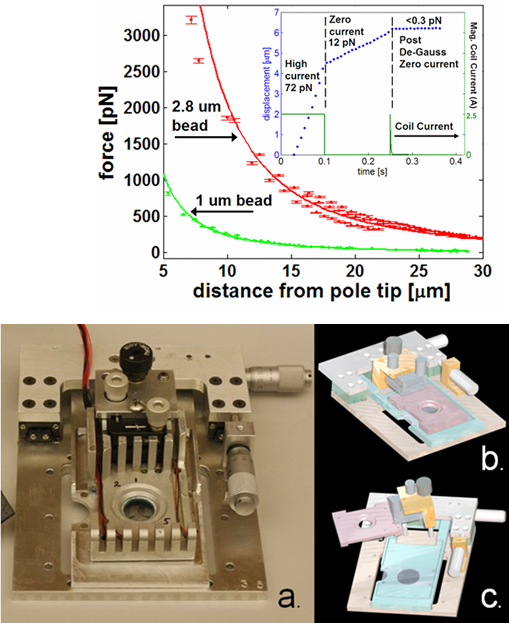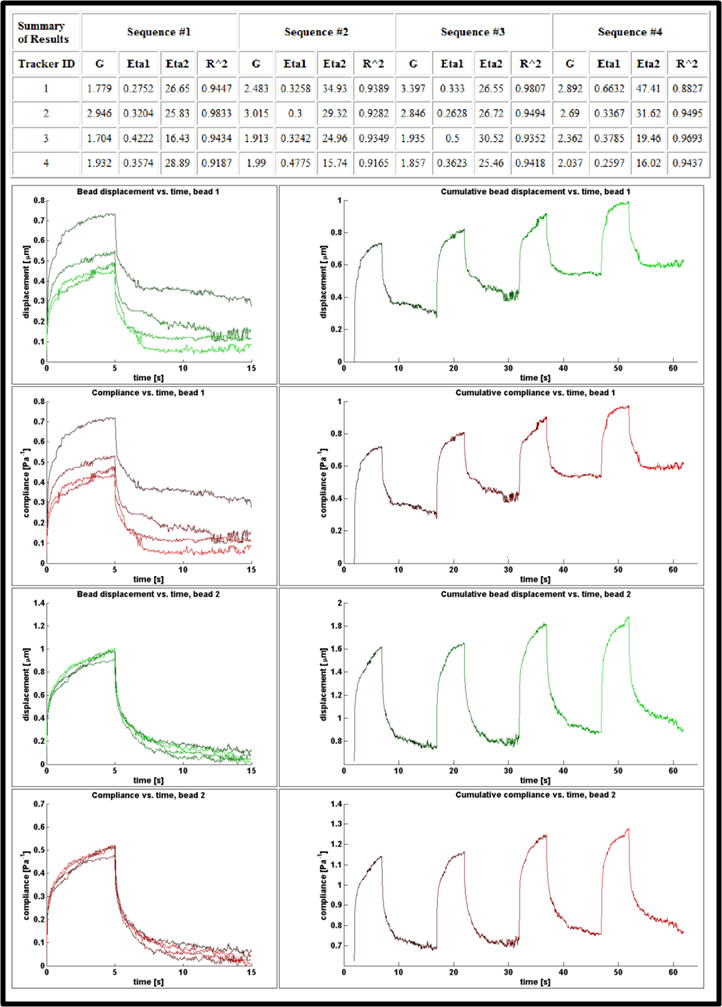3DFM: Three Dimensional Force Microscope
 The 3DFM has been designed to offer nanoNewton forces, to be capable of applying forces in every direction, to have rapid response of over 3kHz and to be compatible with high numerical aperture microscopy. The magnetic flux is generated by current flowing in coils patterned on a circuit board that is integrated into the lid and base of the 3DFM. The force geometry at the specimen, located between the lid and base, is created by pole tips that can be exchanged to alter the forces for different experiments. In its most flexible geometry, forces can be applied in all directions. A typical experiment involves attaching the magnetic bead to a region of interest in the specimen, applying a magnetic force, then measuring the displacement of the bead to gauge the response. This displacement can be measured using video microscopy or laser based tracking for nanometer, submillisecond resolution. The user performs an experiment by using our custom designed software, the 3DFM-UI and VideoSpotracker. We have several systems at our resource integrated with high resolution fluorescence imaging. If you are interested in acquiring the instrumentation for your own lab, please contact us.
The 3DFM has been designed to offer nanoNewton forces, to be capable of applying forces in every direction, to have rapid response of over 3kHz and to be compatible with high numerical aperture microscopy. The magnetic flux is generated by current flowing in coils patterned on a circuit board that is integrated into the lid and base of the 3DFM. The force geometry at the specimen, located between the lid and base, is created by pole tips that can be exchanged to alter the forces for different experiments. In its most flexible geometry, forces can be applied in all directions. A typical experiment involves attaching the magnetic bead to a region of interest in the specimen, applying a magnetic force, then measuring the displacement of the bead to gauge the response. This displacement can be measured using video microscopy or laser based tracking for nanometer, submillisecond resolution. The user performs an experiment by using our custom designed software, the 3DFM-UI and VideoSpotracker. We have several systems at our resource integrated with high resolution fluorescence imaging. If you are interested in acquiring the instrumentation for your own lab, please contact us.
3DFM Cell Mechanics Data Analysis Pipeline
 Computerized measurement systems like the 3D force microscope allow researchers to take in huge amounts of data from a single experiment. Unfortunately, this means that researchers often spend hours painstakingly combing through the data to remove any errors and outliers. This project aims to streamline this analysis process by updating and customizing the 3DFM data processing system, with the goal of providing researchers with an intuitive overview of their cell mechanics data. The overview will combine experimental parameters along with both raw and computed data into a single user interface. By displaying best fit coefficients alongside raw data plots, the interface will allow researchers to quickly visualize data and develop data subsets for more in-depth analysis.
Computerized measurement systems like the 3D force microscope allow researchers to take in huge amounts of data from a single experiment. Unfortunately, this means that researchers often spend hours painstakingly combing through the data to remove any errors and outliers. This project aims to streamline this analysis process by updating and customizing the 3DFM data processing system, with the goal of providing researchers with an intuitive overview of their cell mechanics data. The overview will combine experimental parameters along with both raw and computed data into a single user interface. By displaying best fit coefficients alongside raw data plots, the interface will allow researchers to quickly visualize data and develop data subsets for more in-depth analysis.
O’Brien, E. T., J. Cribb, et al. (2009 (in press)). Magnetic manipulation for force measurements in cell biology. Methods in Cell Biology.
Fisher, J. K., L. Vicci, et al. (2007). Magnetic Manipulation for the Biomedical Sciences. Handbook of Nanoscale Science, Engineering, and Technology, Taylor and Francis.
Fisher, J. K., L. Vicci, et al. (2006). “Magnetic force micromanipulation systems for the biological sciences.” Nano 1(3): 191-205.
Fisher, J. K., J. Cribb, et al. (2006). “Thin-foil magnetic force system for high-numerical-aperture microscopy.” Review of Scientific Instruments 77(2).